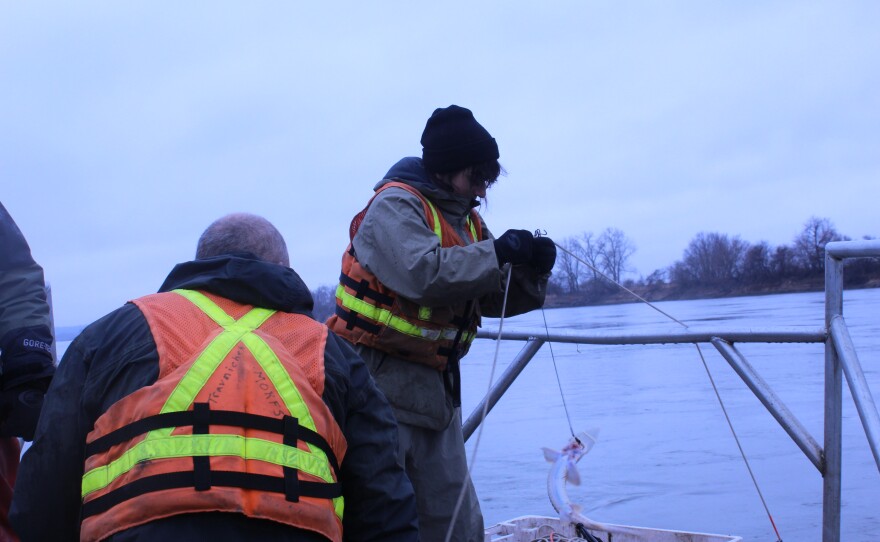The Missouri River has turned into a harsh home for the pallid sturgeon — commonly known as the "Missouri River dinosaur."
The white flat-nosed fish has been on the planet for more than 70 million years, and it’s been on the federal endangered species list since 1990. But genetic research and stocking efforts are helping these ancient bottom feeder species.
The pallid sturgeon has been living in the Missouri River since the Missouri River first formed. They have very small eyes, grow to up to 6-feet long, and can live to be over 50 years old. They’re cartilaginous, meaning they have no bones. They’re completely made of cartilage, like sharks and rays. And though these are all fun little facts, it doesn’t make the pallid sturgeon what you would call the most charismatic endangered species.
Ugly fish
Neil Bass, a biologist for the Army Corps of Engineers admits there aren’t necessarily pallid sturgeon fan clubs out there, and that their ugly appearance doesn’t help them.
"That could be their problem," jokes Bass. "People speculate that’s why they’re endangered. Cause who’d want to breed with that?”
Pallid sturgeon jokes aside, Bass says that changes to the Missouri River have been hard on the fish.
“You know people call the Missouri River the Big Muddy,” says Bass. “But it’s not nearly as muddy as it once was.”
In fact, the river has 80 percent less sediment than it once did, because of dykes, lakes and embankments. The river moves faster, it’s deeper and narrower than it used to be. It’s just a different place than the pallid once knew.
“The Corps actually modified the river to make it better for people, for navigation, to make it habitable on the shores of the Missouri. And we’re never going to move away from that,” Bass says.
So if the river is never going to go back to its natural course, or be what it once was, is it possible for this dinosaur to survive here?
The Corps, which spends $ 1 million annually on pallid sturgeon recovery efforts, thinks so.
“I believe it’s important for us to try and save the species,” says Bass. "Especially one that I guess, we have pushed toward the brink of extinction.”
Every year the last two weeks of March and the first two weeks of April, crews go out onto the Missouri River for broodstock collections. They look for large wild female pallid sturgeons, that ideally haven’t been used before for breeding.
When the Pallid Sturgeon was listed as endangered by the federal government in 1990, their numbers were so low that the Fish and Wildlife Service approved of stocking — breeding wild pallids at hatcheries, to put them back into the river. Female pallids take 15-20 years to reach sexual maturity. So finding just the right fish is a challenge.
Catching the pallid
Kyle Winders is an ecologist with the Missouri Department of Conservation, one of the many agencies that's working with the Corps to save the pallid. He drives one of the boats on the river for broodstock collections. Every day he lays eight trotlines with 40 worm-baited hooks.
He pulls up all kinds of fish in from the lines, catfish, chubs, shovelnose sturgeon, (that’s another sturgeon on the river that often gets confused for the pallid.) They weigh and measure every type of fish caught for research, and then they throw the fish back in.
The technology of tracking
But it gets a lot more complicated once a pallid is caught. They get a lot of extra care. Everything is measured and the water velocity, the turbidity or clarity of the water. Winders says it can take an hour to process a pallid that’s selected to go to a hatchery.
If it’s a fish that already came from the hatchery, which most are, it already has an ID tag implanted.
“We get the number, then we can look up that fish right there in our database,” says Winders’ partner on the boat, Thomas Huffmon. “We’ll know exactly where we caught him how many times we caught him, how much he’s grown. All we need to know about him.”
Even information like the fish’s mother and father, and their brothers and sisters are in the database. Hatcheries are using this data to create a genetic matrix to avoid inbreeding, and to track the species development.
“There was a lot of concern initially about the pallid sturgeon and it’s survivability in the Missouri River. And we know now that adult sturgeon and even like sturgeon older than one year actually do really well in the river," Neil Bass says.
Pallid sturgeons of various sizes have been stocked in the Missouri River since 1992 — 829,000 of them.
Though data shows pallids from birth to one year old still have a hard time surviving, Bass says they know that numbers from the boat ride collections have been increasing over the years.
Kyle Winders' boat, only a week in, has already collected 40 pallids for propagation. That was their boat’s season total for last year. Neil Bass sees this as a sign that their efforts are gaining traction, and hopes life for this Missouri River bottom feeder might be starting to look up.








